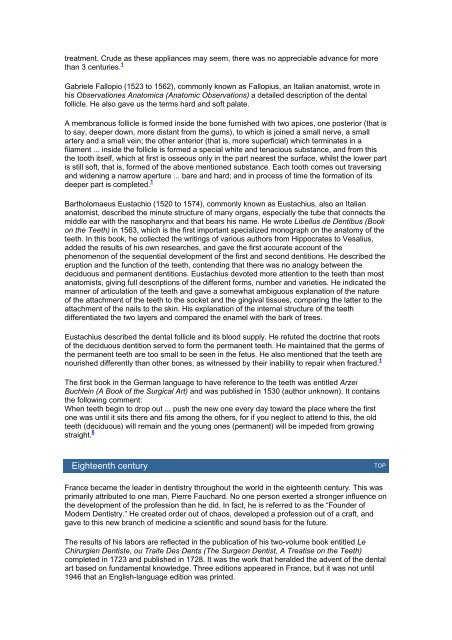A brief history of orthodontics - ortodontia e ortopedia facial
A brief history of orthodontics - ortodontia e ortopedia facial
A brief history of orthodontics - ortodontia e ortopedia facial
Create successful ePaper yourself
Turn your PDF publications into a flip-book with our unique Google optimized e-Paper software.
treatment. Crude as these appliances may seem, there was no appreciable advance for more<br />
than 3 centuries. 1<br />
Gabriele Fallopio (1523 to 1562), commonly known as Fallopius, an Italian anatomist, wrote in<br />
his Observationes Anatomica (Anatomic Observations) a detailed description <strong>of</strong> the dental<br />
follicle. He also gave us the terms hard and s<strong>of</strong>t palate.<br />
A membranous follicle is formed inside the bone furnished with two apices, one posterior (that is<br />
to say, deeper down, more distant from the gums), to which is joined a small nerve, a small<br />
artery and a small vein; the other anterior (that is, more superficial) which terminates in a<br />
filament ... inside the follicle is formed a special white and tenacious substance, and from this<br />
the tooth itself, which at first is osseous only in the part nearest the surface, whilst the lower part<br />
is still s<strong>of</strong>t, that is, formed <strong>of</strong> the above mentioned substance. Each tooth comes out traversing<br />
and widening a narrow aperture ... bare and hard; and in process <strong>of</strong> time the formation <strong>of</strong> its<br />
deeper part is completed. 1<br />
Bartholomaeus Eustachio (1520 to 1574), commonly known as Eustachius, also an Italian<br />
anatomist, described the minute structure <strong>of</strong> many organs, especially the tube that connects the<br />
middle ear with the nasopharynx and that bears his name. He wrote Libellus de Dentibus (Book<br />
on the Teeth) in 1563, which is the first important specialized monograph on the anatomy <strong>of</strong> the<br />
teeth. In this book, he collected the writings <strong>of</strong> various authors from Hippocrates to Vesalius,<br />
added the results <strong>of</strong> his own researches, and gave the first accurate account <strong>of</strong> the<br />
phenomenon <strong>of</strong> the sequential development <strong>of</strong> the first and second dentitions. He described the<br />
eruption and the function <strong>of</strong> the teeth, contending that there was no analogy between the<br />
deciduous and permanent dentitions. Eustachius devoted more attention to the teeth than most<br />
anatomists, giving full descriptions <strong>of</strong> the different forms, number and varieties. He indicated the<br />
manner <strong>of</strong> articulation <strong>of</strong> the teeth and gave a somewhat ambiguous explanation <strong>of</strong> the nature<br />
<strong>of</strong> the attachment <strong>of</strong> the teeth to the socket and the gingival tissues, comparing the latter to the<br />
attachment <strong>of</strong> the nails to the skin. His explanation <strong>of</strong> the internal structure <strong>of</strong> the teeth<br />
differentiated the two layers and compared the enamel with the bark <strong>of</strong> trees.<br />
Eustachius described the dental follicle and its blood supply. He refuted the doctrine that roots<br />
<strong>of</strong> the deciduous dentition served to form the permanent teeth. He maintained that the germs <strong>of</strong><br />
the permanent teeth are too small to be seen in the fetus. He also mentioned that the teeth are<br />
nourished differently than other bones, as witnessed by their inability to repair when fractured. 1<br />
The first book in the German language to have reference to the teeth was entitled Arzei<br />
Buchlein (A Book <strong>of</strong> the Surgical Art) and was published in 1530 (author unknown). It contains<br />
the following comment:<br />
When teeth begin to drop out ... push the new one every day toward the place where the first<br />
one was until it sits there and fits among the others, for if you neglect to attend to this, the old<br />
teeth (deciduous) will remain and the young ones (permanent) will be impeded from growing<br />
straight. 6<br />
Eighteenth century TOP<br />
France became the leader in dentistry throughout the world in the eighteenth century. This was<br />
primarily attributed to one man, Pierre Fauchard. No one person exerted a stronger influence on<br />
the development <strong>of</strong> the pr<strong>of</strong>ession than he did. In fact, he is referred to as the “Founder <strong>of</strong><br />
Modern Dentistry.” He created order out <strong>of</strong> chaos, developed a pr<strong>of</strong>ession out <strong>of</strong> a craft, and<br />
gave to this new branch <strong>of</strong> medicine a scientific and sound basis for the future.<br />
The results <strong>of</strong> his labors are reflected in the publication <strong>of</strong> his two-volume book entitled Le<br />
Chirurgien Dentiste, ou Traite Des Dents (The Surgeon Dentist, A Treatise on the Teeth)<br />
completed in 1723 and published in 1728. It was the work that heralded the advent <strong>of</strong> the dental<br />
art based on fundamental knowledge. Three editions appeared in France, but it was not until<br />
1946 that an English-language edition was printed.


